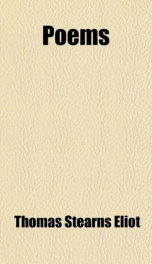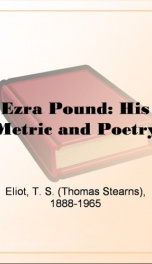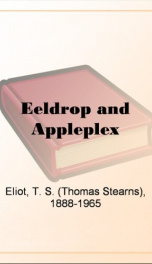Eliot Thomas Stearns

Thomas Stearns Eliot (September 26, 1888–January 4, 1965) was an American poet, playwright, and literary critic, arguably the most important English-language poet of the 20th century.[3] His first notable publication, The Love Song of J. Alfred Prufrock, begun in February 1910 and published in Chicago in June 1915, is regarded as a masterpiece of the modernist movement.[4] It was followed by some of the best-known poems in the English language, including Gerontion (1920), The Waste Land (1922), The Hollow Men (1925), Ash Wednesday (1930), Old Possum's Book of Practical Cats (1939), and Four Quartets (1945). He is also known for his seven plays, particularly Murder in the Cathedral (1935) and The Cocktail Party (1949). He was awarded the Nobel Prize in Literature and the Order of Merit in 1948. Eliot was born in Saint Louis, Missouri, and was educated at Harvard University. After graduating in 1909, he studied philosophy at the Sorbonne in Paris for a year, then won a scholarship to Merton College, Oxford in 1914, becoming a British citizen when he was 39. "[M]y poetry has obviously more in common with my distinguished contemporaries in America than with anything written in my generation in England," he said of his nationality and its role in his work. "It wouldn't be what it is, and I imagine it wouldn't be so good ... if I'd been born in England, and it wouldn't be what it is if I'd stayed in America. It's a combination of things. But in its sources, in its emotional springs, it comes from America."[5] Eliot was born into the Eliot family, originally from New England, who had moved to St. Louis, Missouri.[4] His father, Henry Ware Eliot (1843–1919), was a successful businessman, president and treasurer of the Hydraulic-Press Brick Company in St. Louis. His mother, Charlotte Champe Stearns (1843–1929), wrote poems and was a social worker. Eliot was the last of six surviving children; his parents were both 44 years old when he was born. His four sisters were between 11 and 19 years older than him; his brother was eight years older. Known to family and friends as Tom, he was the namesake of his maternal grandfather Thomas Stearns. From 1898 to 1905, Eliot attended Smith Academy, where he studied Latin, Ancient Greek, French, and German. He began to write poetry when he was 14 under the influence of Edward Fitzgerald's Rubaiyat of Omar Khayyam, a translation of the poetry of Omar Khayyam, though he said the results were gloomy and despairing, and he destroyed them. The first poem that he showed anyone was written as a school exercise when he was 15, and was published in the Smith Academy Record, and later in The Harvard Advocate, Harvard University's student magazine.[6] After graduation, he attended Milton Academy in Massachusetts for a preparatory year, where he met Scofield Thayer, who would later publish The Waste Land. He studied philosophy at Harvard from 1906 to 1909, earning his bachelor's degree after three years, instead of the usual four.[4] Frank Kermode writes that the most important moment of Eliot's undergraduate career was in 1908, when he discovered Arthur Symons's The Symbolist Movement in Poetry (1899). This introduced him to Jules Laforgue, Arthur Rimbaud, and Paul Verlaine, and without Verlaine, Eliot wrote, he might never have heard of Tristan Corbière. He wrote that the book affected the course of his life.[7] The Harvard Advocate published some of his poems, and he became lifelong friends with Conrad Aiken, the American novelist. He worked as a philosophy assistant at Harvard from 1909–1910, then from 1910–1911, he lived in Paris, studying philosophy at the Sorbonne, where he attended lectures by Henri Bergson and read poetry with Alain-Fournier.[7][4] From 1911–1914, he was back at Harvard studying Indian philosophy and Sanskrit.[4][8] He was awarded a scholarship to Merton College, Oxford in 1914. He visited Marburg in Germany first, where he planned to take a summer program, but when the First World War broke out, he went to Oxford instead. There were so many American students at Merton at the time that the Junior Common Room proposed a motion "that this society abhors the Americanization of Oxford," defeated by two votes after Eliot reminded the students how much they owed American culture.[9] But he didn't settle at Merton, and left after a year. He wrote to Conrad Aiken on New Year's Eve 1914: "I hate university towns and university people, who are the same everywhere, with pregnant wives, sprawling children, many books and hideous pictures on the walls ... Oxford is very pretty, but I don't like to be dead."[9] By 1916, he had completed a PhD dissertion for Harvard on Knowledge and Experience in the Philosophy of F.H. Bradley, about F.H. Bradley but he failed to return for the viva voce.[4] In a letter to Aiken late in December 1914, Eliot, aged 26, wrote, "I am very dependent upon women (I mean female society)," and then added a complaint that he was still a virgin.[10] Less than four months later, Thayer introduced Eliot to Vivienne Haigh-Wood, Cambridge governess. They were married at Hampstead Register Office on June 26, 1915.[11] After a short, unaccompanied visit to his family in the United States, he returned to London and took several teaching jobs such as lecturing at Birkbeck College, University of London. The philosopher, Bertrand Russell, took an interest in Eliot's wife while the newlyweds stayed in his flat. Some scholars have suggested that she and Russell had an affair, but the allegations were never confirmed.[12] In a private paper written in his sixties, Eliot confessed: "I came to persuade myself that I was in love with Vivienne simply because I wanted to burn my boats and commit myself to staying in England. And she persuaded herself (also under the influence of [Ezra] Pound) that she would save the poet by keeping him in England. To her, the marriage brought no happiness. To me, it brought the state of mind out of which came The Waste Land."[13] Their relationship was the subject of a film in 1994, Tom and Viv. After leaving Merton, Eliot worked as a schoolteacher, most notably at Highgate School, a private school, where he taught French and Latin[4]—his students included the young John Betjeman—and later at the Royal Grammar School, High Wycombe a state school in Buckinghamshire. To earn extra money, he wrote book reviews and lectured at evening extension courses. In 1917, he took a position at Lloyds Bank in London, working on foreign accounts. On a trip to Paris in August 1920, he met the writer James Joyce and artist Wyndham Lewis. Eliot said he found Joyce arrogant—Joyce doubted Eliot's ability as a poet at the time—but the two soon became friends, with Eliot's visiting Joyce whenever he was in Paris.[14] In 1925, he left Lloyds to join the publishing firm Faber and Gwyer, later Faber and Faber, where he remained for the rest of his career, eventually becoming a director. Wyndham Lewis and Eliot became close friends, a friendship leading to Lewis's well-known painting of Eliot in 1938 (see lead image, above). On June 29, 1927 Eliot converted to Anglicanism, and in November that year took British citizenship. He became a warden of his parish church, Saint Stephen's, Gloucester Road, London,[15] and a life member of the Society of King Charles the Martyr.[16] By 1932, Eliot had been contemplating a separation from his wife for some time. When Harvard offered him the Charles Eliot Norton professorship for the 1932-1933 academic year, he accepted and left Vivien in England. Upon his return, he separated from her, avoiding all but one meeting with her between his leaving for America in 1932 and her death in 1947. Vivien was committed to the Northumberland House mental hospital, Stoke Newington, in 1938, and remained there until she died. Although Eliot was still her husband during this time, he never visited.[17] While in hospital, she wrote to Eliot: "I am sorry I tortured you and drove you mad. I had no notion until yesterday afternoon that I had done it. I have been simply raving mad. You need not worry about me."[3] From 1946 to 1957, Eliot shared a flat with his friend John Davy Hayward, who gathered and archived Eliot's papers, styling himself "Keeper of the Eliot Archive".[18] Hayward also collected Eliot's pre-Prufrock verse, commercially published after Eliot's death as Poems Written in Early Youth. When Eliot and Hayward separated their household in 1957, Hayward retained his collection of Eliot's papers, which he bequeathed to King's College, Cambridge in 1965. Eliot's second marriage was happy. On January 10, 1957, he married Esmé Valerie Fletcher, 37 years younger than him. In contrast to his first marriage, Eliot knew Fletcher well, as she had been his secretary at Faber and Faber since August 1949. They kept their wedding secret; the ceremony was held in a church at 6.15 a.m. with virtually no one in attendance other than his wife's parents. Since Eliot's death, Valerie has dedicated her time to preserving his legacy; she has edited and annotated The Letters of T. S. Eliot and a facsimile of the draft of The Waste Land. In the early 1960s, by then in failing health, he served as an editorial consultant to the Wesleyan University Press, Connecticut, seeking out new poets in Europe for publication.[19] Eliot died of emphysema in London on January 4, 1965. For many years he had had health problems owing to his heavy smoking, and had often been laid low with bronchitis or tachycardia. His body was cremated at Golders Green Crematorium. According to Eliot's wishes, the ashes were taken to St Michael's Church in East Coker, the village from which his ancestors had emigrated to America. There, a simple wall plaque commemorates him with a quotation from his poem "East Coker": "In my beginning is my end. In my end is my beginning." On the second anniversary of his death, he was commemorated by the installation of a large stone in the floor of Poets' Corner in London's Westminster Abbey. The stone is inscribed with his dates, his Order of Merit, and a quotation from his poem, "Little Gidding": "the communication / Of the dead is tongued with fire beyond / the language of the living."
do you like this author?
What readers are saying
What do you think? Write your own comment on this book!
write a commentWhat readers are saying
What do you think? Write your own comment on this author!
write a commentBook list

Prufrock and Other Observations
Series:
Unknown
Year:
Unknown
Raiting:
2.5/5
A first collection of poems by Thomas Stearns Eliot, an Anglo-American twentieth century poet, playwright, and literary critic. Published in 1917. It includes the first important work of the author - a lyric “The Love Song of Alfred Prufrock”, 1911-1913, which gave the name to this volume. Eliot began as a poet of despair, expressing his deep disgust for the world of bourgeois platitude. His poetry has the seal of bitter disappointment with the reality. Eliot creates a portrait of a hero, who lacks his individual traits being a parody of insipid stereotypes of the liberal humanistic way of thinking. “The Love Song of Alfred Prufrock”, appearing to be a milestone of the twentieth century poetry, describes an obliging, deferential courtier, painfully indecisive and stumbling over his words.
Show more
add to favoritesadd In favorites

Poems
Series:
Unknown
Year:
Unknown
Raiting:
2.5/5
Purchase of this book includes free trial access to www.million-books.com where you can read more than a million books for free. This is an OCR edition with typos. Excerpt from book: Portrait of a Lady Thou hast committed Fornication: but that was in another country, And besides, the wench is dead. The Jew Of Malta. Among the smoke and fog of a December afternoon You have the scene arrange itself as it will seem to do With " I have saved this afternoon for you "; And four wax candles in the darkened room, Four rings of light upon the ceiling overhead, An atmosphere of Juliet's tomb Prepared for all the things to be said, or left unsaid. We have been, let us say, to hear the latest Pole Transmit the Preludes, through his hair and finger-tips. " So intimate, this Chopin, that I think his soul Should be resurrected only among friends Some two or three, who will not touch the bloom That is rubbed and questioned in the concert room." And so the conversation slips Among velleities and carefully caught regrets Through attenuated tones of violins Mingled with remote cornets And begins. " You do not know how much they mean to me, my friends, And how, how rare and strange it is, to find In a life composed so much, so much of odds and ends, (For indeed I do not love it ... you knew? you are not blind! How keen you are!) To find a friend who has these qualities, Who has, and gives Those qualities upon which friendship lives. How much it means that I say this to you Without these friendships life, what cauchemar! " Among the windings of the violins And the ariettes Of cracked cornets Inside my brain a dull tom-tom begins Absurdly hammering a prelude of its own, Capricious monotone That is at least one definite " false note." Let us take the air, in a tobacco trance, Admire the monuments Discuss the late events, Correct our watches by the public clocks. Then sit for half an hour and drink our bocks. Now that l...
Show more
add to favoritesadd In favorites
Book list

Prufrock and Other Observations
Series:
Unknown
Year:
Unknown
Raiting:
2.5/5
A first collection of poems by Thomas Stearns Eliot, an Anglo-American twentieth century poet, playwright, and literary critic. Published in 1917. It includes the first important work of the author - a lyric “The Love Song of Alfred Prufrock”, 1911-1913, which gave the name to this volume. Eliot began as a poet of despair, expressing his deep disgust for the world of bourgeois platitude. His poetry has the seal of bitter disappointment with the reality. Eliot creates a portrait of a hero, who lacks his individual traits being a parody of insipid stereotypes of the liberal humanistic way of thinking. “The Love Song of Alfred Prufrock”, appearing to be a milestone of the twentieth century poetry, describes an obliging, deferential courtier, painfully indecisive and stumbling over his words.
Show more
add to favoritesadd In favorites

Poems
Series:
Unknown
Year:
Unknown
Raiting:
2.5/5
Purchase of this book includes free trial access to www.million-books.com where you can read more than a million books for free. This is an OCR edition with typos. Excerpt from book: Portrait of a Lady Thou hast committed Fornication: but that was in another country, And besides, the wench is dead. The Jew Of Malta. Among the smoke and fog of a December afternoon You have the scene arrange itself as it will seem to do With " I have saved this afternoon for you "; And four wax candles in the darkened room, Four rings of light upon the ceiling overhead, An atmosphere of Juliet's tomb Prepared for all the things to be said, or left unsaid. We have been, let us say, to hear the latest Pole Transmit the Preludes, through his hair and finger-tips. " So intimate, this Chopin, that I think his soul Should be resurrected only among friends Some two or three, who will not touch the bloom That is rubbed and questioned in the concert room." And so the conversation slips Among velleities and carefully caught regrets Through attenuated tones of violins Mingled with remote cornets And begins. " You do not know how much they mean to me, my friends, And how, how rare and strange it is, to find In a life composed so much, so much of odds and ends, (For indeed I do not love it ... you knew? you are not blind! How keen you are!) To find a friend who has these qualities, Who has, and gives Those qualities upon which friendship lives. How much it means that I say this to you Without these friendships life, what cauchemar! " Among the windings of the violins And the ariettes Of cracked cornets Inside my brain a dull tom-tom begins Absurdly hammering a prelude of its own, Capricious monotone That is at least one definite " false note." Let us take the air, in a tobacco trance, Admire the monuments Discuss the late events, Correct our watches by the public clocks. Then sit for half an hour and drink our bocks. Now that l...
Show more
add to favoritesadd In favorites

Ezra Pound: His Metric and Poetry
Series:
Unknown
Year:
Unknown
Raiting:
1/5
This book was converted from its physical edition to the digital format by a community of volunteers. You may find it for free on the web. Purchase of the Kindle edition includes wireless delivery.
Show more
add to favoritesadd In favorites

Eeldrop and Appleplex
Series:
Unknown
Year:
Unknown
Raiting:
1/5
This book was converted from its physical edition to the digital format by a community of volunteers. You may find it for free on the web. Purchase of the Kindle edition includes wireless delivery.
Show more
add to favoritesadd In favorites
What readers are saying
What do you think? Write your own comment on this author!
write a commentif you like Eliot Thomas Stearns try:
readers also enjoyed
What readers are saying
What do you think? Write your own comment on this author!
write a commentif you like Eliot Thomas Stearns try:
readers also enjoyed
Do you want to exchange books? It’s EASY!
Get registered and find other users who want to give their favourite books to good hands!

